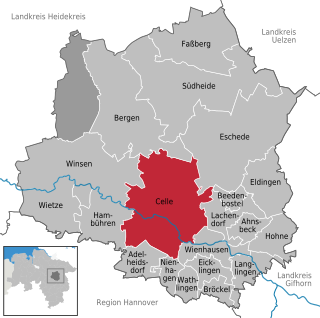
Celle is a town and capital of the district of Celle, in Lower Saxony, Germany. The town is situated on the banks of the river Aller, a tributary of the Weser and has a population of about 71,000. Celle is the southern gateway to the Lüneburg Heath, has a castle built in the Renaissance and Baroque style and a picturesque old town centre with over 400 timber-framed houses, making Celle one of the most remarkable members of the German Timber-Frame Road. From 1378 to 1705, Celle was the official residence of the Lüneburg branch of the dukes of Brunswick-Lüneburg who had been banished from their original ducal seat by its townsfolk.
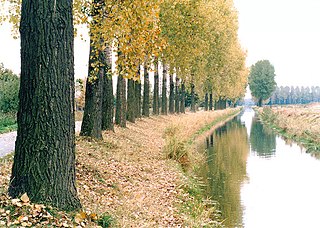
The Aller is a 215-kilometre-long (134 mi) river in the states of Saxony-Anhalt and Lower Saxony in Germany. It is a right-hand, and hence eastern, tributary of the Weser and is also its largest tributary. Its last 117 kilometres (73 mi) form the Lower Aller federal waterway (Bundeswasserstraße). The Aller was extensively straightened, widened and, in places, dyked, during the 1960s to provide flood control of the river. In a 20-kilometre-long (12 mi) section near Gifhorn, the river meanders in its natural river bed.

Amelinghausen is a municipality in the district of Lüneburg in Lower Saxony, Germany. It is also the seat of the collective municipality (Samtgemeinde) of Amelinghausen.
The Principality of Lüneburg was a territorial division of the Duchy of Brunswick-Lüneburg within the Holy Roman Empire, immediately subordinate to the emperor. It existed from 1269 until 1705 and its territory lay within the modern-day state of Lower Saxony in Germany. The principality was named after its first capital, Lüneburg, which was ruled jointly by all Brunswick-Lüneburg lines until 1637. From 1378, the seat of the principality was in Celle. It lost its independence in 1705 when it was annexed by the Electorate of Brunswick-Lüneburg, but retained its vote in the Reichstag as Brunswick-Celle.
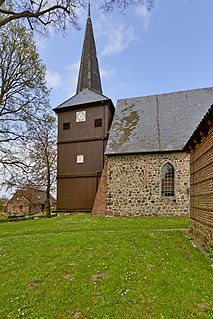
Bovenau is a village in the district of Rendsburg-Eckernförde, in the German state of Schleswig-Holstein. Bovenau is only 16 metres (52 ft) above sea level. The location is south of the municipality of Bünsdorf or Sehestedt, but north of Ostenfeld, Bredenbek, and west of Krummwisch, about 20 km (12 mi) away from the center of Kiel.
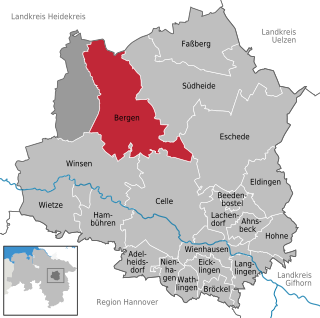
Bergen is a town in the north of Celle district on the Lüneburg Heath, in Lower Saxony, Germany. Administratively it acts as a municipal borough divided into 12 subordinate parishes based on the town and its surrounding villages: Becklingen, Belsen, Bergen, Bleckmar, Diesten, Dohnsen, Eversen, Hagen, Hassel, Offen, Sülze and Wardböhmen. Bergen-Belsen concentration camp was located in the area of Belsen.

Faßberg is a municipality in the district of Celle, in Lower Saxony, Germany. It is situated approximately 35 km north of Celle, and 30 km west of Uelzen.

Unterlüß is a village and former municipality in the district of Celle in Lower Saxony, Germany. It became part of the municipality of Südheide on 1 January 2015. It is about 30 km north-east of Celle and 25 km south-west of Uelzen. It is a station on the railway between Hanover and Hamburg.
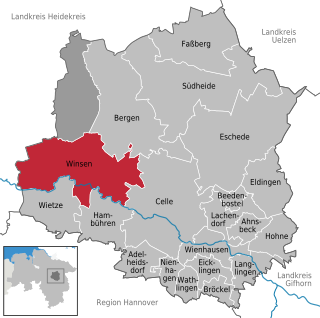
Winsen an der Aller or Winsen (Aller) is a town in the district of Celle in the German state of Lower Saxony.

Winsen (Luhe) is the capital of the district of Harburg, in Lower Saxony, Germany. It is situated on the small river Luhe, near its confluence with the Elbe, approx. 25 km southeast of Hamburg, and 20 km northwest of Lüneburg.

Deizisau is a town in the district of Esslingen in Baden-Württemberg in southern Germany. It belongs to the Stuttgart Region (until 1992 Region Mittlerer Neckar) and the Stuttgart Metropolitan Region. Deizisau is located between the towns of Plochingen and Esslingen am Neckar, about 20 kilometers southeast of Stuttgart, the capital of Baden-Württemberg. The river Neckar flows through this town.

Dettingen is a municipality in the district of Esslingen in Baden-Württemberg in southern Germany.

Örtze is a river of Lower Saxony, Germany. The Örtze rises north of Munster in the Große Heide and, after 62 kilometres (39 mi), joins the Aller southeast of Winsen.
The Osthannoversche Eisenbahnen AG (OHE) is a Celle based transportation company with railway network in North-eastern Lower Saxony around the Lüneburg Heath area of over 250 km.

Eversen is a village in the town of Bergen in the northern part of Celle district on the Lüneburg Heath in the north German state of Lower Saxony.

The Aller-Leine Valley is the name of a region north of Hanover in Germany, that has been created for the purpose of regional marketing and inter-community cooperation. The Aller-Leine Valley initially only included the three collective municipalities of Ahlden, Rethem an der Aller and Schwarmstedt in the district of Soltau-Fallingbostel, that are situated on the southwestern edge of the Lüneburg Heath where the River Leine discharges into the Aller. Since 2001 the neighbouring municipalities of Hambühren, Wietze and Winsen an der Aller as well as Dörverden and Kirchlinteln have become part of the Aller-Leine Valley region. The unifying theme and characteristic feature of the region is the river landscape of the Aller and Leine rivers.

Walle is a village and Ortschaft of the municipality of Winsen (Aller) in Celle district, Lower Saxony, on the Lüneburg Heath in Germany.

Thören is a village on the southern edge of the Lüneburg Heath in the north German state of Lower Saxony. It is located in the Aller-Leine Valley and is an Ortschaft of the municipality of Winsen (Aller).

Wolthausen is a village (Ortsteil) in the municipality of Winsen (Aller) in the district of Celle in the north German state of Lower Saxony. It lies on the River Örtze in the Aller valley and on the B 3 federal road.

Otto Haesler was an influential German architect.




















